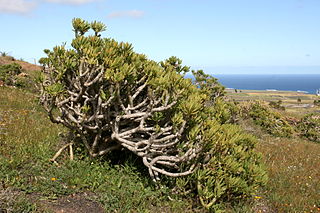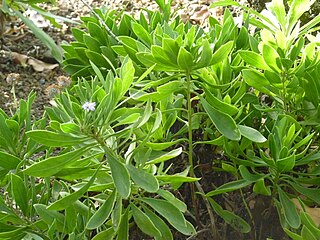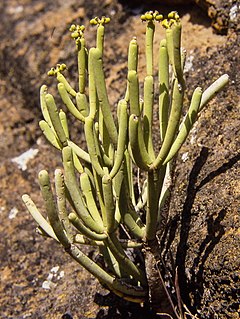
Globularia is a genus of about 22 species of flowering plants in the family Plantaginaceae, native to central and southern Europe, Macaronesia, northwest Africa and southwest Asia. They are dense low evergreen mat-forming perennials or subshrubs, with leathery oval leaves 1–10 cm long. The flowers are produced in dense inflorescences (capitula) held above the plant on a 1–30 cm tall stem; the capitula is 1–3 cm in diameter, with numerous tightly packed purple, violet, pink or white flowers.

Argyranthemum is a genus of flowering plants belonging to the family Asteraceae. Members of this genus are sometimes also placed in the genus Chrysanthemum.

Euphorbia atropurpurea, called tabaiba majorera or tabaiba roja in Spanish, is a shrub in the family Euphorbiaceae native to Tenerife in the Canary Islands. It can reach 2 metres in height, and grows in ravines, and on slopes and terraces.

Kleinia neriifolia, known in Spanish as verode or berode, is a species of flowering plant in the daisy family (Asteraceae). It is endemic to the Canary Islands. It was formerly named Senecio kleinia.

Sideroxylon mirmulans, commonly known as marmulano, is a species of flowering plants in the family Sapotaceae. It is endemic to the Madeira Islands (Portugal). It is threatened by habitat loss.

Hypericum canariense is a species of flowering plant in the family Hypericaceae known by the common name Canary Islands St. John's wort. It is the sole member of Hypericumsect. Webbia.

Argyranthemum frutescens, known as Paris daisy, marguerite or marguerite daisy, is a perennial plant known for its flowers. It is native to the Canary Islands. Hybrids derived from this species are widely cultivated as ornamental plants in private gardens and public parks in many countries, and have naturalized in Italy and southern California. There are many cultivars, but the most common has white petals.

Aeonium ciliatum is a species of flowering plant in the family Crassulaceae that produces large green leaf rosettes, which can be 50 cm across. The rosettes emerge from a woody stem that branches freely and can become very top heavy. It is endemic to Tenerife in the Canary Islands, where it prefers some shade, and is frequent in the Anaga peninsula in the north east of the island.

Aeonium canariense is a species of flowering plant in the family Crassulaceae. It is endemic to the island of Tenerife in the Canary Islands, where it grows on dry slopes and cliffs in the north of the island from sea level to about 1300m. It forms large rosettes of leaves close to the ground but the spikes of yellow flowers stand up to 70 cm tall.

Geranium reuteri, the giant geranium, is a species of flowering plant in the family Geraniaceae, native to the Canary Islands and Madeira. It was known for many years under the name Geranium canariense. In Spanish, it is called pata de gallo.

Hypericum grandifolium is a species of flowering plant in the St. John's wort family Hypericaceae. It is native to Madeira and the Canary Islands. It is an evergreen shrub up to 1.8 m in height, with dark green, leathery leaves covered with warty glands, and bright yellow flowers up to 4.5 cm broad. It is an important constituent of the shrub layer in the laurisilva of La Gomera.

Globularia salicina is a shrub native to the archipelago of Madeira and to the central and western Canary Islands.

Globularia amygdalifolia is a flowering plant of the family Plantaginaceae. The species is endemic to Cape Verde. It is listed as an endangered species by the IUCN.

Globularia sarcophylla is a plant endemic to Gran Canaria, where it is rare and confined to basalt mountain cliffs of the Caldera de Tirajana, Los Leales, La Culata etc. around 1,600 m (5,200 ft) in elevation. Its leaves small, obovate, fleshy, about 2 cm (0.79 in) long. The flowers are blue. Flower heads are solitary about 1.5 cm (0.59 in) across, on 5–6 cm (2.0–2.4 in) long terminal peduncles.

Canarina canariensis is a species of flowering plant in the bellflower family Campanulaceae, commonly known as the Canary Island bellflower, and known locally as bicácaro.

Sonchus acaulis is a plant species in the dandelion tribe within the daisy family. It is found only on the Canary Islands of Gran Canaria and Tenerife.

Euphorbia aphylla is a species of flowering plant in the family Euphorbiaceae. It is native to the Canary Islands. It was first described in 1809.

Sonchus congestus is a species of flowering plant in the family Asteraceae. It is endemic to the Canary Islands.

Helianthemum canariense is a species of flowering plant in the family Cistaceae, native to Western Sahara, Morocco and the Canary Islands.

Pericallis echinata is a species of flowering plant in the family Asteraceae. It is native to Tenerife in the Canary Islands.




















